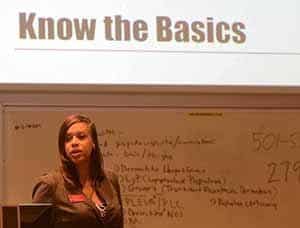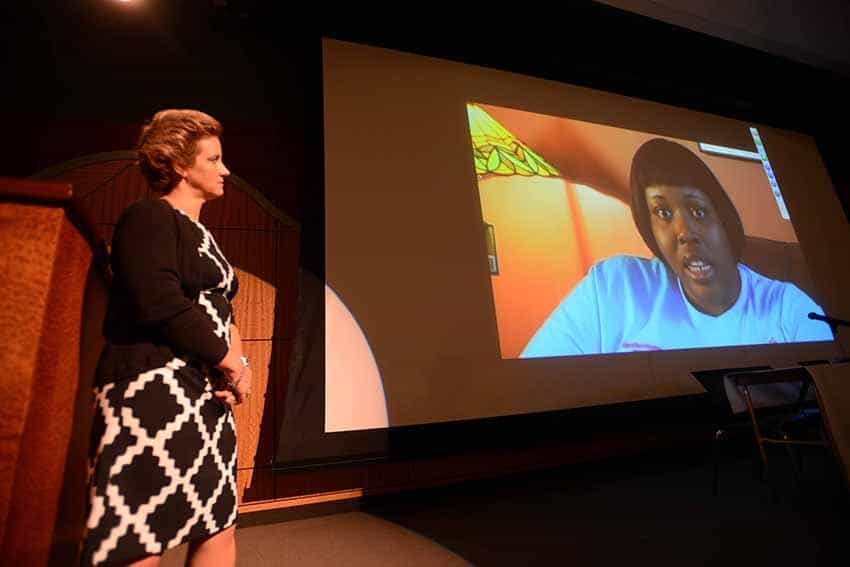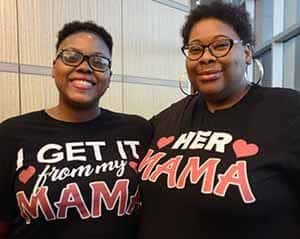Advocacy, Expertise on Display at UAMS’ Sickle Cell Symposium
| Oct. 12, 2016 | After attending the Sickle Cell Symposium at UAMS, Dalissa Robinson didn’t feel as alone in coping with her sickle cell disease as she sometimes does.
“I was impressed by what strong advocates the symposium speakers are,” Robinson said. “We don’t have enough advocates for sickle cell disease. I like how they are standing up for us. I don’t want to feel as confrontational as I feel I have to be sometimes because of my health care. I get very frustrated.”
The Sickle Cell Symposium was presented by Future Builders Inc. in collaboration with the UAMS Adult Sickle Cell Clinical Program.
Robinson and her mother, Nicole Smith, both live in Malvern. Both wore T-shirts emblazoned with big letters. Smith’s shirt read, “Her Mama,” and Robinson’s shirt read, “I Get It From My Mama.”
Smith carries the sickle cell genetic trait for sickle cell disease, a severe hereditary form of anemia in which blood hemoglobin becomes distorted into a crescent or sickle cell shape. The disease is most common among people of African descent and can result in severe pain when the sickle cells block blood flow in small blood vessels.
Smith said she was impressed by the leadership she saw on display at the symposium, and she came away with some new knowledge, too.

Stella Bowers, R.N., works in the UAMS Adult Sickle Cell Clinical Program and staffed an informational booth at the symposium.
“I appreciate the fact that they are trying to get legislation passed making sickle cell more of a priority disease like heart attacks and diabetes,” Smith, who recently became a registered nurse, said. “I learned last night about some different IV fluids that can be beneficial to sickle cell patients. It’s been interesting to hear.”
At the opening evening session Oct. 6, Barbie Brunner, UAMS director of Patient- and Family-Centered Care, discussed “Engaging Patients and Families for Quality and Safety.” At 7 p.m. LaKisha Johnson, executive director of Sickle Cell Support Services in Little Rock, presented “Advocating for Yourself: Patient Practices for Successful Health.”
The guest speaker opening the morning session Oct. 7 was Stephanie Figueroa, P.A.-C, senior emergency medicine physician assistant at Johns Hopkins Hospital in Baltimore. In her presentation of “Sickle Cell Rapid Evaluation & Acute Management (SCREAM) for Acute Pain Crisis Patients in the E.D. — A Safe and Standardized Approach,” she explained the history of the Johns Hopkins SCREAM program and its results.
“We turned it into advocacy,” Figueroa said. “We’re going to SCREAM for those patients in a pain crisis. We know they’re hurting and we want to get them care in a faster fashion that’s appropriate and focused on their needs. This is where SCREAM came from and now it has become a verb in our department. When we ‘scream’ a patient, it means they have gone through the protocol we developed.”
Using the SCREAM protocol, emergency medicine clinicians quickly identify sickle cell patients in the Emergency Department (ED) at Johns Hopkins who are experiencing a severe pain crisis. They are assigned to an observation clinic in the ED with the goal of getting them to a health care provider in no more than 30 minutes and having pain medication administered in 90 minutes or less.

LaKisha Johnson makes her presentation to the Thursday night audience at the symposium. She also participated in a panel discussion at the closing of the event.
The ED there is able to accomplish that for more than 70 percent of its sickle cell pain patients. In 2000 before the SCREAM protocols and plan were in place, wait times averaged three hours and could be as long as 12.
The program also has reduced hospital admission for sickle cell pain patients from 75 percent in 2000 to 15 percent today, Figueroa said.
After Figueroa spoke, Elizabeth Storm, M.D., an attending physician in the ED at Arkansas Children’s Hospital presented “Sickle Cell Disease — A Pediatric Emergency Department Perspective.” Storm joined Figueroa, Johnson, and Pooja Motwani, M.D., and Megan Davis, M.D., in a panel discussion of issues related to pain medication, dependence and addiction. Motwani and Davis are co-directors of the UAMS Adult Sickle Cell Clinical Program.

